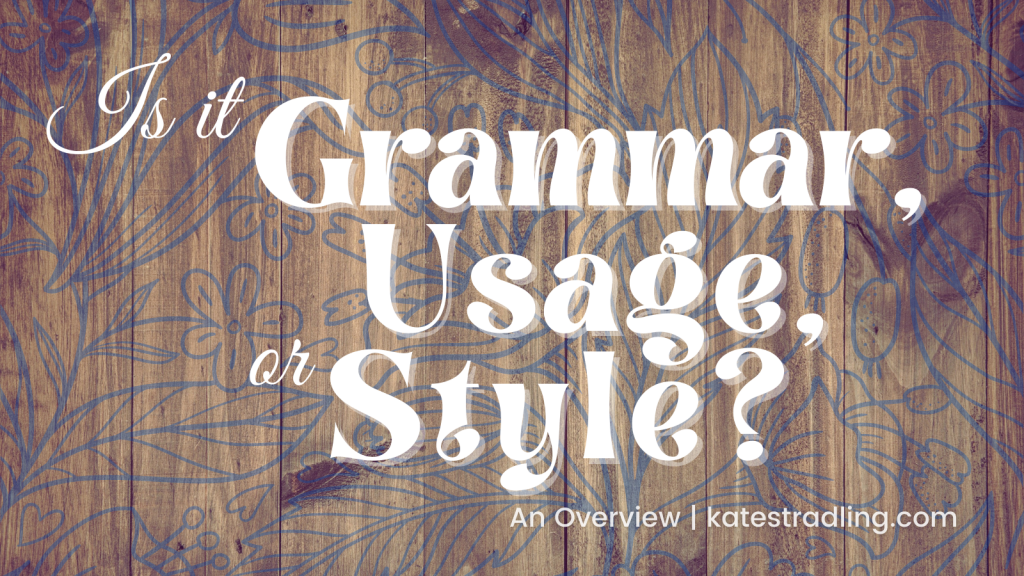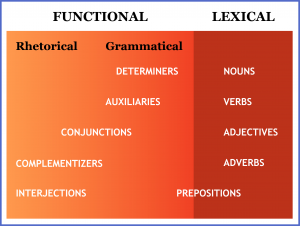 In my local writer’s group last month, I had the assignment to teach a lesson on anything under the sun that was writing-related. And, being that my expertise lies in the sere landscape of language structure, I opted to explore the differences between grammar, usage, and style.
In my local writer’s group last month, I had the assignment to teach a lesson on anything under the sun that was writing-related. And, being that my expertise lies in the sere landscape of language structure, I opted to explore the differences between grammar, usage, and style.
We often hear these terms used interchangeably. More often, people lump all things language-related into the “grammar” category, which kind of drives my pedantic self crazy. So, in the interest of better understanding all around, here’s a quick run-down for your reading pleasure.
The basics:
- Grammar describes the system of patterns by which a particular language functions.
- Usage outlines the application of language patterns in the standard vernacular of that language.
- Style dictates the preferred language patterns of an individual, publisher, or industry.
Long story short (too late), many, many “grammar” complaints are actually a matter of usage or style.
Grammar
Grammar involves the building blocks of language: parts of speech, clause and sentence structures, and how those sentences tie to their surrounding contexts.
Building Blocks

Every part of speech has its own set of features and rules for how it interacts with other parts of speech. For example, verbs can have features of tense, mood, aspect, and voice. They also have agreement rules for when they combine with their subjects (nouns or pronouns), matching in number.
- The cat walks. (singular subject, 3rd singular verb)
- Two cats walk. (plural subject, 3rd plural verb)
Languages vary in how they apply their rules. Take the same example above, but in Hungarian:
- A macska sétál (“the cat walks”; singular subject, 3rd singular verb)
- Két macska sétál (“two cats walk”; in Hungarian grammar, a number before a noun keeps the plurality feature to itself, so the subject and verb here remain singular; the listener still understands that there is more than one cat)
- A macskák sétálnak (“the cats walk”; plural subject, 3rd plural verb)
(Also, apologies for my Hungarian. 1,000 days on Duolingo has not an expert made in me, haha.)
And of course, as parts of speech combine into phrases and clauses, additional rules of word order, movement, subordination/coordination, etc., come into play.
Value Judgements in Grammar
Because grammar is descriptive, it abstains from value judgements. It doesn’t even have to make semantic sense. Noam Chomsky’s infamous sentence, “colorless green ideas sleep furiously,” is 100% grammatical, even though the words repeatedly contradict themselves.
In addition, aberrations in grammar can signal a restrictive code (a different regional vernacular, for example). They are usually systematic in their own way.
I.e., they indicate a different pattern—a different grammar—at play. There is no such thing as an inferior language or dialect.
Common Mistakes
Common grammar mistakes in writing include the aforementioned subject-verb agreement, inconsistent verb tenses, and, on the broader structural level, misplaced modifiers or ambiguous sentence structures (where two separate meanings exist depending on how the reader reads the sentence).
If it’s not a structural issue, it’s not a grammar mistake. Which brings us to
Usage
“Usage” specifies how native speakers apply their rules of grammar. It defines the standard within a language community. In this realm you will find such enlightenment as
- whether to use “affect” vs. “effect”
- when it’s “less” vs. “fewer”
- expectations regarding subjunctive “be”
Sometimes, usage actually defies the rules of grammar.
- “aren’t I” vs. “ain’t I” (“ain’t” = contraction of “am not” but Usage doesn’t like it, so the 1st singular pronoun here takes a 1st plural verb in its preferred form)
- “that’s them” vs. “those are they” (try saying that second one in mixed company and see the looks you get, hahaha)
Value Judgements in Usage

So because usage deals with predominant standards, value judgements abound. Dictionaries of Usage exist for the express purpose of explaining what is correct vs. preferred vs. incorrect.
Violations can be nonstandard, colloquial, dialectical, or informal. But note, none of these are necessarily wrong, except that they’re not commonly used or preferred by the community from which the standard originates.
Also, keep in mind that usage rules consider both past and present patterns, and are thus changeable over time. You might think “irregardless” isn’t a word, but usage contradicts you.
(It’s also why “literally” can now mean “figuratively.” Sorry, not sorry.)
Common Mistakes
There are too many to list, even in categories. I own a 971-page usage dictionary that expounds on correct vs. incorrect word choices, and it’s by no means all-inclusive.
To be blunt, no one has perfect usage. We each apply patterns as we understand them against an ever-changing standard.
And if you think that’s unsettling, just wait until you get a load of
Style
Here we have arrived at the bane of every writer’s existence. Style gives guidelines for preferred usage, particularly when multiple options exist. It is the method by which we choose what language will best communicate to our desired audience the nebulous soup of ideas that swirls around in our brains.
(Say that ten times fast.)
And it is subjective to whoever dictates it.
Examples of guidelines for preferred usage
- Oxford comma: Chicago, APA, MLA all say yes! AP says no!
- Since vs. because: “Since is more precise when it is used to refer only to time (to mean ‘after that’); otherwise, replace with because.” (APA, 5th ed., section 2.10)
- Pied-piping (“Don’t end a sentence in a preposition; it’s completely grammatical and people talk that way all the time, but we don’t like it.”)
- List structures (e.g., “start all list items with the same part of speech”)
- And, of course, the tear-inducing requirements for citation formatting that vary from one discipline to the next
Personal Style
In addition to established style guides, every author has their own style. This is the arena of literary devices: irony, alliteration, litotes, diction, etc. Style includes how a writer chooses to employ (or ignore) tropes and figures of speech in conveying their message.
An author’s personal style
- supports the building of their tone: formal or informal, light-hearted or heavy, serious or sarcastic, etc.
- takes sentence variation into account
- Someone who writes only subject-verb-object displays a simpler style, whereas the writer who varies sentence lengths and degrees of subordination will have a more developed style.
- Variety of structure can indicate the intended audience of the work. (E.g., younger audience = simpler structures)
Value Judgements in Style
As with Usage, value judgements abound here, but also, STOP JUDGING PEOPLE FOR USING THEIR PREFERRED STYLES. JUST ACCEPT THAT YOU’RE NOT THEIR INTENDED AUDIENCE AND MOVE ALONG.
*deep breaths*
Style varies from guide to guide and author to author. It can always improve, because writing is a craft that we constantly refine.
Final Thoughts
Everyone has an individual perception of grammar, usage, and style. Everyone. None of us is infallible, because we speak a language in constant flux.
Combined, these three elements create your literary fingerprint. This is how linguistic analysis can determine whether an anonymous work was written by a particular author. It’s why no one else can write that story that’s burning inside of you the same way that you would write it.
By distinguishing these three terms from one another, we can better develop our understanding and proficiency in each. More importantly, I hope, we can exercise greater compassion toward others in their usage and style choices.
Best wishes to you all!
***
For more information on this subject, check out the Grammar, Usage, and Style tabs at Grammarist.com, Merriam-Webster.com’s Grammar and Usage topics, the Chicago Manual of Style, Strunk & White’s Elements of Style, the Publication Manual of the American Psychological Association, the MLA Handbook for Writers of Research Papers…
So many resources. Just type “grammar usage style” into the search engine of your choice and enjoy the deluge.